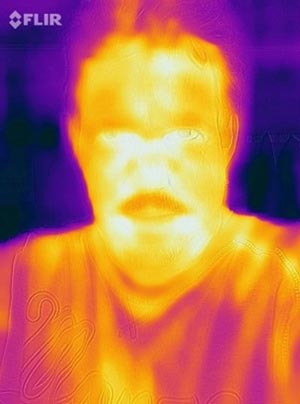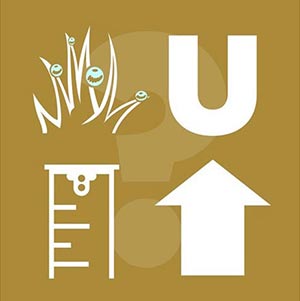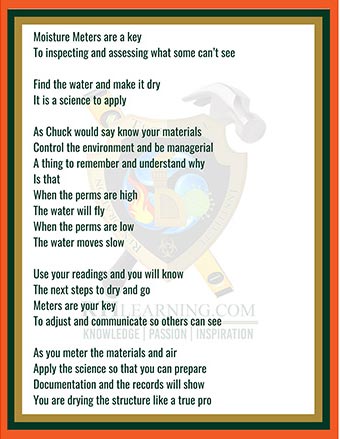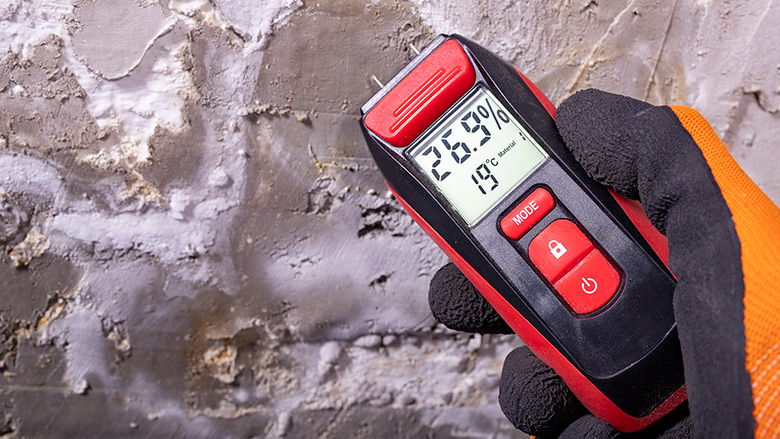In order to have as successful drying project, one must have a complete and accurate scope of work. There are many parts to a proper scope, and one of the most important contributing factors is accurate and complete moisture level readings on the materials present. This seems much easier to do than it actually is, however, advancements in meter technology, software applications, and online training for monitoring technicians are making the process more efficient and improving accuracy.
“Moisture Meters” need to be understood to acquire accurate readings. The first thing to remember is that no moisture meter directly measures moisture.

Thermal Imaging cameras are not moisture meters but they serve many great purposes. The most important of which is the ability to scan a room quickly to find temperature anomalies. The areas with cooler temperatures may indicate evaporation off a surface, or “evaporative cooling.” These potentially “wet” areas need to be followed up with a moisture meter to get accurate moisture content readings.
Always remember, if the water cannot evaporate off the surface area, there may be no evaporative cooling effect on the material, thus the camera will not see a temperature differential and you may falsely assume the material is dry. This is known as a false negative and could result in wet materials left out of the scope of work increasing the potential for microbial amplification.
Non-invasive (non-penetrating or scan) type meters typically use a system of signal impedance. This basically means a signal or energy wave is sent out from the emission section of the meter, transmitted through the material and received by another section of the meter. The degradation or variation of this signal is compared to a calibrated reference, the scale you select, and displays the information as a reading we record on our “moisture map.”
The concept is simple, a hydroscopic material that is in equilibrium with its environment, at its dry standard or normal equilibrium moisture content, has a certain number of pores or air pockets. When these pores are filled with excess water, the density of the material changes from normal to a higher density. Water is obviously denser than air, so the signal changes when the water is encountered and that is what the meters “see,” “interpret” and “read” to us. “More moisture — more dense — more wet.” Since materials naturally have different densities, you need different scales or a known NEMC or dry standard reference.
Invasive meters use a system of electric current passage. Invasive meters have been around longer and operate a little simpler. Invasive meters usually have two pins or contact points designed so current (electricity) can be passed from one point to the other. As most people know, water is more conductive than air, so as pores fill with water the material typically becomes more conductive. The more conductive, the more current passes, the higher the reading on the meter. “More conductive reads more wet.” Again, materials vary in conductivity so you must choose a scale and compare the reading to a known NEMC or dry standard for that material, in that climatic area, during that time of the year, on that model meter, on that scale. No shortcuts here.

As you can see, proper training on the type of meters, the materials they are used on and how to interpret the data requires a skill set. On my very first project in the late ‘80s, I was handed two meters and told to “scan and stab, write it down, call me if you have questions.” This was on a multistory commercial loss. I was a young field engineer and thought, "No problem." On day one most of the areas were wet, on day two fewer areas were wet, day three was even better, but the corners of the walls were still reading saturated! My assumption: Water was trapped behind the metal corner bead. Actually, of course, it was the metal corner bead, no moisture but it was reading the higher density material, metal corner bead, on the drywall scale. No problem, it was actually dry, so all was good.
More recently, a similar mistake by an untrained technician ended with disastrous results. He used the drywall scale on drywall, but it was double layer fire-rated (Type “X”) drywall. So, anybody that has carried fire rock and general purpose rock knows the difference in weight. They are materials of different density. So, a huge amount of perfectly dry fire rock was removed and discarded because it read “elevated” on the drywall scale. This was called into question as the loss was being processed. The contractor was found responsible for the unnecessary removal and the replacement of all the firewalls in that section of the building, resulting in a huge cash loss for the contractor.
Look into online training for all your critical path training to bolster what they learn in the field and from attending in-person, hands-on training classes. Do not hand the “new hire” a meter and say “scan and stab it, and write down the readings”. The thermal imaging world has online training for multiple skill levels, and now this is happening for moisture meter monitoring.
Learn more about tools and best practices for water damage restoration
Automated tracking systems are now coming back, with great new additions, mapping apps and integration possibilities into multiple software platforms. A concern here is will your meter work with your software? The biggest concern, truly the worst, would be getting caught up in a system where you have to use their meter, their app, their software only and now they own you. Make sure the system you get into is flexible, easy for all your people to learn and use, and of course, cost effective. Make sure the dog is wagging the tail, not the other way around!
For all you R&R readers out there, we have attached a great Poem by Lisa Lavender. The worlds’ first “restoration poet.”

Also, attached are links to downloadable “Simple Steps Monitoring” and other relevant articles previously published in R&R magazine.
- Simple Steps: Monitoring a Water Loss
- Do You Measure Up?
- Moisture Mapping Large Commercial Buildings
- Restoring Success: It's All About Perspective
Wishing you a successful drying career.

